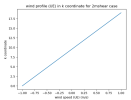Hello,
I am not able to compile WRF v4.2.1 with the vortex-following option serially using the Intel option (option 13) for the test case = em_quarter_ss. I successfully compiled using the no-nest option using compiling option 13. I found that this issue may have been addressed in WRF v4.4.1 so I downloaded and tried that version. Again, I was not able to compile with the vortex-following nest using option 13 (Intel) but I was able to using the no-nest option.
I found this thread (WRF4.4 compilation failed on vortex following nesting) and tried the suggested changes in the configure.wrf file using WRF 4.2.1 and it again did not compile correctly. Every time there is an error I get the same error. I have attached the error log from my last attempt that include: WRFV4.2.1 with vortex-following option, Intel compiler (option 13) with the edits suggested from the link above . I prefer to stay with WRFv4.2.1 since I am going to be using the time-varying point-downscaling method (Onderlinde and Nolan 2017) and the most up-to-date version the code is compatible with is 4.2.1
I have logically debugged the furthest I can for now, so help is greatly appreciated!!
I am not able to compile WRF v4.2.1 with the vortex-following option serially using the Intel option (option 13) for the test case = em_quarter_ss. I successfully compiled using the no-nest option using compiling option 13. I found that this issue may have been addressed in WRF v4.4.1 so I downloaded and tried that version. Again, I was not able to compile with the vortex-following nest using option 13 (Intel) but I was able to using the no-nest option.
I found this thread (WRF4.4 compilation failed on vortex following nesting) and tried the suggested changes in the configure.wrf file using WRF 4.2.1 and it again did not compile correctly. Every time there is an error I get the same error. I have attached the error log from my last attempt that include: WRFV4.2.1 with vortex-following option, Intel compiler (option 13) with the edits suggested from the link above . I prefer to stay with WRFv4.2.1 since I am going to be using the time-varying point-downscaling method (Onderlinde and Nolan 2017) and the most up-to-date version the code is compatible with is 4.2.1
I have logically debugged the furthest I can for now, so help is greatly appreciated!!

